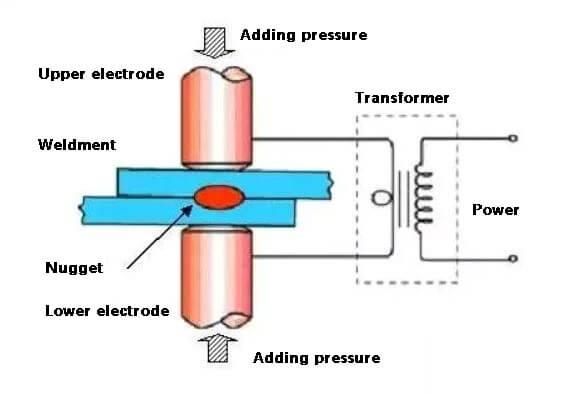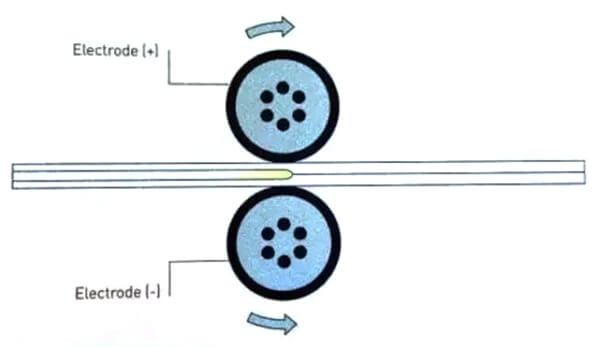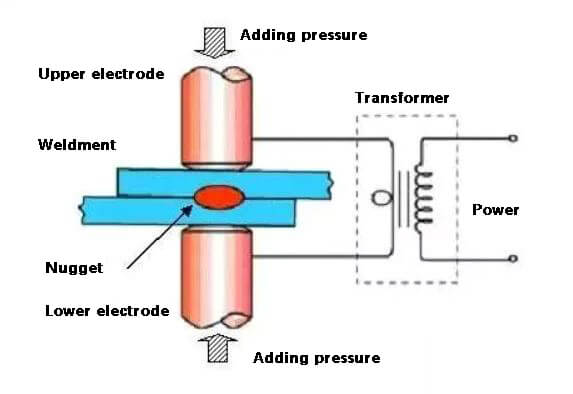Definition of Resistance Welding and Laser Welding
Resistance welding
Resistance welding is a manufacturing process and technology used to join metals or other thermoplastic materials, such as plastics, by heating. This welding method involves applying pressure across the electrode after combining the part and utilizing the resistance heat generated by the current passing through the contact surface and the adjacent joint area.
laser welding
Laser welding is a high-efficiency, precise, non-contact, pollution-free and radiation-free welding method that uses a high-energy density laser beam as a heat source.

Spot welding is mainly used for welding sheets.
Spot welding process
① Pre-press to ensure good contact with the workpiece.
② Connect to form a nugget and plastic ring at the welding joint.
③ Turn off forging to make the nugget cool and crystallize under the continuous action of pressure to form a weld joint with dense structure and no shrinkage cavity and cracks.
2. Seam welding
Seam welding is similar to spot welding in its process, but instead of using cylindrical electrodes, it uses a disc-shaped rotating roller electrode. The metal parts to be welded are positioned in a lap or butt joint and placed between the two roller electrodes. The roller applies pressure and rotates, applying force continuously or intermittently to create a continuous weld.
Seam welding is commonly used for welding structures that require regular welding and sealing and is typically used on metal plates less than 3mm thick.

3. Projection welding
Projection welding is a type of spot welding that involves the use of preformed protrusions on the workpiece. During the projection welding process, one or more nuggets may be formed in the joint simultaneously.
4. Resistance butt welding
Resistance butt welding is a process that joins metal parts in a butt joint configuration by placing their end faces in close contact, heating them to a plastic state through resistance heating, and then applying pressure quickly after turning off the power to complete welding.
This method is mainly used to weld metal parts of simple shapes, with a diameter or side length of less than 20 mm and with low strength requirements.
5. Flash butt welding
Flash butt welding is a process that joins metal parts in a butt joint configuration by gradually bringing the end faces into close contact, heating these contact points through resistance heating, creating a flash under the influence of high current, melting the metal at the end, and then apply pressure quickly after turning off the power when the metal reaches the desired temperature within a certain depth range.
The joint quality of flash welding is superior to that of resistance welding, and the mechanical properties of the welded joint are equivalent to those of the base metal. There is no need to clean the joint surface before welding.
Butt-to-butt flash welding is often used to weld crucial metal parts and can be used to weld the same metal or different metals, as well as metals ranging from 0.01mm metal wire to 20,000mm metal bars and profiles.
Disadvantages of resistance welding:
Currently, there is a shortage of reliable non-destructive testing methods to evaluate welding quality, and it can only be evaluated through destructive testing of process samples and workpieces, as well as various monitoring technologies.
The lap joint used in spot and seam welding not only adds weight to the component but also creates an angle around the weld nugget of the two plates, leading to low tensile strength and low fatigue strength of the joint.
The equipment used in welding has high power and high levels of automation, making it expensive and difficult to maintain. Commonly used high-power single-phase AC welding machines can also upset the balance of the electrical grid.
Advantages of laser welding:
Laser welding minimizes heat input and reduces the size of the metallurgical change in the heat-affected zone, leading to minimal heat conduction deformation.
The workpiece can be placed in a closed environment such as a vacuum or controlled gas environment.
High-speed welding can be easily achieved through automation and the process can be controlled by digital or computational means.
With perforated welding, the weld bead can have a depth-to-width ratio of up to 10:1.
It is not affected by magnetic fields, unlike arc and electron beam welding, and allows precise alignment of work pieces.
A wide range of materials can be welded, including dissimilar materials.
There is no need for electrodes, avoiding contamination or damage problems.
As it is a non-contact welding process, there are minimal losses and deformations of machines and tools. No vacuum or x-ray protection is required.
The laser beam can be easily redirected to multiple workstations.
When welding thin materials or small diameter wires, there is no risk of reflow, as is common in arc welding.
The process parameters for single-pass welding of a 32 mm thick sheet have been verified and can reduce the time required to weld thick sheets and eliminate the need for filler metal.
The laser beam can be focused on small, closely spaced areas, making it ideal for welding small parts.
The laser beam is easily guided and aligned using optical instruments and can be positioned far from the workpiece, easily bypassing obstacles.
This flexibility allows welding in areas where other welding methods cannot be used.
Laser welding can also be used to join metals with different physical properties, such as varying strengths.
Conclusion
Laser welding offers numerous advantages over traditional resistance welding, including superior weld quality, savings and benefits.
It has a wide range of applications and is an essential component for future welding processes.
The only downside is that the initial purchase cost can be relatively high.
However, its capabilities, production efficiency and benefits far surpass those of any other welding equipment.

























































